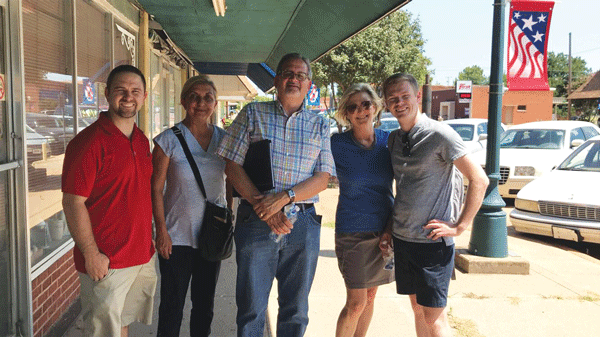
Editor’s Note: This is a story by Jacob Eck and Lauren Nitschke
As part of the Chisholm Trail and the Rock Island Railroad, Waurika has a wonderful and rich history. However, as it is with many small towns, Waurika has seen many key components of history and industry pass on with time.
The questions and challenges that Waurika faces are much of the same ones that all small towns are having. When the larger industries left, so did many residents and small businesses. Empty buildings are on every block, some areas look worn out and forgotten, side streets diminish the feel of comfort and safety.
Additionally, walkability and accessibility need attention, and most of all, we want to create a “place” with staying power. After 6 pm, activity downtown slows to a crawl.
How can we get people back to Main Street after work? How can our parks be of more benefit to our citizens? Empty buildings and parks are screaming for more activity.
It was only a year ago when a large group of community members pulled together to polish up our town for the upcoming Smithsonian Exhibit, “The Way We Worked”. Over 300 people volunteered their time and resources to help put our beautiful Rock Island Depot and Main Street in its best possible light. The excitement and momentum that event created continue still. We’re seeing new community enhancements develop, like the almost completed disc golf course at Harmon Park and Waurika Farmers Market on Main Street. In fact, so many new ideas have sprung up over the past year that city leaders and the Chamber of Commerce were faced with a challenge: how to prioritize these much desired amenities and how to make all the parts work together to become a whole, rather than a bunch of stand alone, non-integrated projects. In short, Waurika needs a plan.
But not just any old plan! With the Waurika Chamber of Commerce taking the lead role, it was decided that Waurika should apply for a unique program offered by the Institute for Quality Communities, which is a part of the University of Oklahoma’s College of Architecture. Each year, the IQC solicits applications and awards partnerships to a handful of Oklahoma towns for a variety of community enhancement initiatives. This spring, the Chamber was notified that our application was chosen for inclusion in the IQC and College’s 2018-2019 school year programming. Waurika also a received a matching grant from Oklahoma Municipal League to help cover transportation and administrative costs involved. By making use of design students and existing curricula, costs to participant communities is kept to a minimum. The first step of this exciting collaborative process began last Friday, June 29, with the arrival on Main Street of 3 IQC staff members: director Shane Hampton, Hope Mander, and Ron Frantz. Chamber board members Jacob Eck and Lauren Nitschke spent the day with the trio walking both sides of Main Street, examining our historic buildings and history, touring the Veterans Memorial Park, the Depot and Harmon Park, and discussing our community’s assets, needs, desires, and visions for the future. Our visitors expressed continuous delight at the beauty of our Main Street, and marveled at the dedication of our residents to keep it looking so good. Architect Ron Frantz said he particularly appreciated the quantity and quality of the downtown buildings, noting that Waurika is blessed with several blocks of mostly intact structures. He said that is not the case in most of Oklahoma’s small towns.
It was also discovered during Friday’s meeting that, as an added benefit, the IQC is well acquainted and works continuously with various state agencies and professional organizations which have access to consultation and funding resources for ongoing progress toward our future goals.
In the coming weeks, the Chamber will receive a document from the IQC summarizing their observations and outlining proposals for how their organization and the College of Architecture’s students and faculty can collaborate with the citizens of our community to discover and meet our most pressing needs. The next steps include additional on-site meetings, opportunities for community input, and field visits by various students and staff members.
Jacob Eck remarked, “We feel that seeking out guidance from the IQC is going to be extremely impactful. It is always beneficial to bring fresh eyes, new ideas, and expertise to the table whenever possible. If we are successful in focusing our path forward, it will have a ripple effect in our community. We can energize our citizens. We can attract new businesses and families that will in turn impact our school. We can develop spaces that invite activity and creativity, and it will help us shape our town for our next generation. If successful, we will catch “our second wind.” “
Paraphrased below, The IQC website explains more about their role in Oklahoma communities:
As then OU President Boren, who along with his wife Molly Shi Boren founded the IQC, expressed in his book A Letter to America, “Every decision should be made with the goal of increasing community.” To pursue this goal, the IQC trains students and connect citizens, professionals, and civic leaders with knowledge that builds on tradition to reshape towns and cities for the future.
[They] collaborate with faculty and students from The University of Oklahoma, as well as cutting-edge practitioners from around the world, to enhance our understanding of the built environment’s influence on quality of life. Through the IQC’s engagements with communities and civic leaders, our OU team helps the citizens of Oklahoma reshape their towns and cities in ways that improve our state’s social ties, environment, and economy.
Waurika Chamber of Commerce
The Chamber plays a very active role in Waurika. The Chamber’s primary mission is to help stimulate economic growth in our city. The Chamber works to bring in new businesses, support existing business, and take the lead on projects that help improve our Main Street and overall economic health.